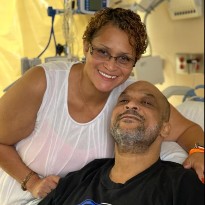Heart valve repair corrects the damage to an affected valve to restore cardiovascular health. In minimally invasive valve-repair surgery, also called least invasive valve surgery (LIV), the surgeon makes a small incision in the chest that allows them to see the valve and repair the damage. There are two main types of minimally invasive heart-repair surgical procedures:
Thoracoscopic surgery
The surgeon will make a small incision (or incisions) in the chest and insert a thin tube called a thoracoscope. This long tube contains a small video camera so the surgeon can clearly see the heart valve. Long, thin instruments are used to repair the valve damage.
Robot-assisted surgery
The surgeon will make a small incision (or incisions) in the chest. Then, the surgeon controls the robotic arms to accurately perform the valve repair. Clear images of the heart are available on a computer screen that the surgeon uses while guiding the robotic arms.
When the mitral valve (located between the heart’s left atrium and left ventricle) malfunctions, the flaps of the valve become thick or stiff and may fuse together. In a minimally invasive procedure, the surgeon can repair or replace the defective valve through a small incision in the chest.
Transcatheter Edge-to-Edge Repair (TEER)
TEER is a procedure that repairs problems of the mitral valve. It is an alternative to valve replacement for patients who have less severe damage and can avoid open-heart surgery. The MitraClip® system is often used for this type of repair. The process involves inserting a tiny clip, through a catheter, into the heart to repair the mitral valve. The clip is inserted through an artery and does not involve incisions in the chest.
Aortic Valve Replacement (AVR)
With traditional, open surgery, the surgeon makes a large incision in the chest, temporarily stops the heart, and places the patient on a bypass machine while the replacement valve is placed. In a minimally invasive AVR procedure, the surgeon works through a small incision or incisions, and the heart continues to beat throughout the procedure.
The surgeon makes several small incisions and exposes only the sections of the arteries that require graft placement. Because the entire heart is not exposed, as it is during traditional open-heart surgery, the minimally invasive procedure minimizes scarring and lowers the risk of infection.
This procedure is appropriate for patients with severe aortic stenosis (thickening of the aortic valve that prevents it from fully opening) who are at an intermediate or high risk for significant complications from traditional open-heart surgery. In a TAVR procedure, a new, artificial aortic valve is collapsed and inserted through a catheter in the chest or leg. Once the device is in the correct position, it is expanded and stays in place to take over for the diseased or damaged aortic valve.
TEVAR is a minimally invasive alternative to open surgical repair for diseases of the thoracic aorta. The procedure is most commonly used to correct a thoracic aneurysm (an abnormal bulge in a weakened aortic wall). Using the TEVAR procedure, the surgeon inserts a fabric-covered metal stent into the aneurysm as a replacement for the diseased segment of the aorta.
EVAR is a minimally invasive procedure to repair an abdominal aortic aneurysm (AAA), which is an enlarged, bulging section of the abdominal aorta caused by a weakened section of the artery wall. In this minimally invasive procedure, using local anesthesia, the surgeon makes small incisions in the patient’s groin and threads catheter tubes through the femoral arteries and into the aorta. A fabric-covered metal stent is introduced through the artery and fixed in place, relieving pressure on the artery to prevent rupture.
Complete Coronary Revascularization in Higher-Risk and Indicated Patients (CHIP) or Hand Angioplasty
This is a relatively new procedure that has shown success treating advanced scleroderma in the hands. Physicians affiliated with Memorial Hermann are on the forefront of this minimally invasive percutaneous revascularization to correct occlusions in the large vessels of the hand.
Percutaneous Coronary Intervention (PCI) for Chronic Total Occlusion (CTO)
Percutaneous coronary intervention (PCI), also called angioplasty, is a minimally invasive procedure to open blocked arteries that slow or block blood flow to the heart. During the procedure, a deflated balloon attached to a catheter is inserted into a blood vessel through an incision, usually in the arm or groin. From there, X-ray technology and contrast dye are used to guide the balloon-tipped catheter through the blood vessel and into the blocked coronary artery. Once in place, the balloon is inflated which compresses some of the plaque against the wall of the artery. When the balloon is deflated and removed, the plaque remains compressed, and the artery stays open. Frequently, a stent (wire mesh tube) may be left in the artery to support the arterial walls after the balloon is removed.
Atrial Septal Defect (ASD) Repair
An atrial septal defect is a hole in between the left and right atrium of the heart. The condition is a congenital (present at birth) defect that can be repaired during cardiac catheterization. The physician inserts a thin, flexible tube (catheter) through a small incision in the groin and guides the catheter through a blood vessel until it reaches the ASD. A small patch or closure device is then inserted to close the hole and correct the defect.
Patent Foramen Ovale (PFO) Repair
Patent foramen ovale is a small opening between the heart’s left and right atria that develops after birth. Most patients with this condition do not need treatment. For patients who are at an increased risk of stroke, the physician may recommend closing the defect so that blood does not flow between the chambers. PFO repair involves guiding a thin, flexible tube (catheter) through a small incision in the groin, through a blood vessel, until the defect is reached. A small patch or closure device is then inserted to close the hole and correct the defect.
Patients with atrial fibrillation (AFib) may be at a higher risk of stroke caused by blood clots that form in the left atrial appendage (LAA). The LAA is a small pocket (or recess) connected to the upper left chamber of the heart that, in people with AFib, can allow blood to pool and collect and increase the likelihood of a clot forming and traveling to the brain to cause a stroke. Patients at Memorial Hermann have access to the latest innovative treatment options to seal the LAA and reduce the risk of stroke caused by non-valvular AFib.

